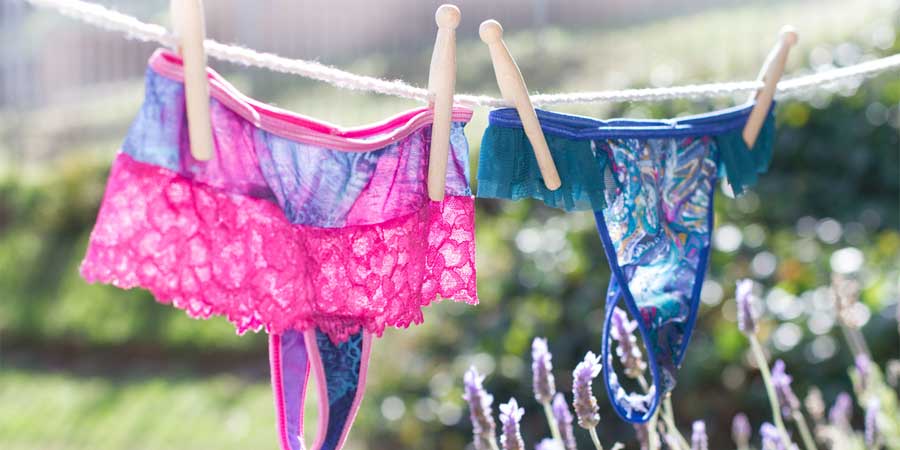Lingerie Care Guidelines
Posted by Jean Lesley on Sep 25th 2017

Taking proper care of your lingerie will keep bras, panties, hosiery and shapewear looking fresh and fitting properly longer. Although lingerie loses elasticity over time, some laundering tips will help your lingerie live a long life.
Your lingerie will last longer if you...
- Hand wash
- Use a lingerie bag if machine washing.
- Always use cold or warm water.
- Wash delicates with other delicates. Heavy fabrics like denim can tangle with bras.
- Avoid washing lingerie in the same load as towels. No lint.
- When hand washing, don't wring garments out or twist tightly.
- Separate light and dark colors.
BRAS
Even though most labels say to hand-wash bras, everyday bras can safely go through the washing machine. Just keep in mind that the gentler cycle, the better with little to no spin. For extra protection, place each bra in a lingerie bag-clasped in the back to avoid snagging.
If necessary, you can pre-treat perspiration stains with mild soap and water, and gentle rubbing, and then let soak for a few minutes. Use only cold or warm water. Hot water can break down fabrics and elastic. Hook the bra together to avoid snagging it on other clothing. Ornate or delicate bras are best washed by hand, using a gentle fabric wash.
Soak
the bra for a few minutes and then gently work the suds through the
material and rinse. A good way to get excess water out is to roll the
bra in a towel before laying it out to dry. Do not put bras in the
dryer. The heat breaks down spandex and elastic and generally wreaks
havoc on fine lingerie.
PANTIES
Look at the care instructions on the label. Except for delicate fabrics and ornate decoration, many panties can be washed in the machine.
If there are stains, apply a delicate wash or stain treatment and let the panties soak for a few minutes. Then, wash in the machine using the delicate cycle on warm or cold and wash with other lightweight items. Mesh lingerie bags will keep panties from twisting or catching on other garments. If you prefer washing cotton undies in hot water, do so, although it may shorten the life of your panties.
Like bras, air-dry. The dryer is not lingerie's friend.
SHAPEWEAR
Even if the care instructions allow for machine washing, your best bet is to wash shapewear by hand. If you are using the machine, use cold or warm water and avoid chlorine bleach. Air or line dry.
HOSIERY
We've
been washing stockings and panty hose by hand since mom first taught us
how. Tights and other hosiery may not have to be washed after every
wear, but do wash after a few wears. Start by soaking hosiery in a sink
filled with cool or tepid water. Add a detergent made for delicates and
gently swish your stocking or tights around. Then let them soak for 30
min. if you have time. Rinse in cold water and gently wring out
moisture. Hang to dry.
How to Launder Specific Fabrics
Acetate
Most acetate garments should be dry-cleaned. Acetate is adversely affected by acetone and other organic solvents, such as nail polish remover and perfumes containing such solvents Some knits can be hand washed in warm water with mild soap. Do not soak colored items. Press while damp on the wrong side with an iron.
Acrylics
Acrylic
lingerie should be hand washed in warm water. Gently squeeze out water
then smooth or shake garment out. Hang to dry on a non-rusting hanger.
Use a warm iron if pressing is required.
Acrylic garments may be washed or dry-cleaned. When machine washing, use warm water setting and add a fabric softener during the final rinse cycle. Dry at low temperature. Remove from dyer as soon as garments are dry. Static electricity can be reduced by using s fabric softener in every third or fourth washing. Gently squeeze out water, smooth or shake out garment and let dry on a non-rust hangar. If ironing is required, use moderately warm iron.
Cotton
Cotton
can be washed in hot water and chlorine bleach on whites. Cotton,
unlike most lingerie can be put in the dryer with moderate to high heat.
But to prolong the life of cotton undies, you may also wash them the
way you would other delicates.
Cotton can withstand high temperatures and relatively aggressive detergents. Chlorine bleach can be used safely on cotton whites. Use color safe bleach on dyed cottons. Cotton fabrics wrinkle easily and may need frequent pressing. A higher heat setting is needed in the dryer to dry cotton. Cotton can be ironed with a hot iron, and does not scorch easily.
Linen
Some linens are washable, while others are dry clean only. Washable linen apparel can be laundered easily and become softer with use. White linens should be dried in the sun to help them to keep their whiteness. Linen fabrics may need frequent pressing.
Lyocell
Lyocell garments may be either machine washed and dried or dry-cleaned. Machine wash and dry at low temperature. Remove from dryer as soon as the garment is dry. If ironing is required, use a moderately warm iron.
Microfiber
Acrylic, nylon and polyester microfibers should be machine washed and dried or can be dry-cleaned. Follow the instructions for washing fabrics consisting of these individual fibers.
Nylon
One of
the easiest lingerie fabrics to care for, nylon can be machine washed
warm and tumble dried at a low temperature. You may want to add fabric
softener to the rinse cycle. A dryer sheet will reduce static.
So most nylon can be machine washed and tumbled dried at low temperatures. Use warm water and add a fabric softener to the final rinse cycle. To minimize static electricity use a dyer sheet when machine drying. Remove articles from the dyer as soon as the tumbling cycle is completed. If ironing is required, use a warm iron.
Polyester
Most polyester can be machine washed with warm water and dried on low. Polyester can also be dry-cleaned.
Polyester can be machine washed and dried or dry-cleaned. Use warm water and add a fabric softener to the final rinse cycle. Machine dry at low temperature setting and remove articles as soon as the drying is complete. If ironing is needed, use a moderately warm iron.
Rayon
Most rayon garments should be dry-cleaned. Check the care instruction as some items can be hand or machine washed.
Silk
Detergent
and dyes in other garments are not kind to silk. Ideally, silk should
be dry-cleaned. If your silk lingerie has no lining or embellishments,
silk can be washed gently in detergent meant for delicate items and
tepid water. Never use chlorine bleach.
Only pre-washed silks are washable. Dry-cleaning is generally preferred, since laundry detergents and dyes in other clothes may adversely affect silk fabric. For washable silk, follow the care instructions carefully using only mild soap and lukewarm water. Chlorine bleach should never be used on silk. For long-time storage, silk should be sealed against light, air and insects.
Spandex
Lingerie
containing spandex can be hand or machine-washed, but check the care
instructions first. If hand washing, make sure to rinse thoroughly,
especially if using color-safe bleach. Then drip dry. If machine
washing, use a low temperature. If ironing is required, iron quickly on a
low setting.
Triacetate
Pleated garments are best hand laundered. Most other garments containing 100% triacetate can be machine washed. A high temperature setting may be used to iron. Articles containing triacetate require little care.
Rayon
Most rayon should be dry-cleaned, but some types of fabric construction can be hand or machine washed. For washable items, use mild lukewarm or cool suds, gently squeeze suds through the fabric and rinse in lukewarm water. Do not wring or twist, instead smooth or shake the article out and place on a non-rust hanger to dry. Press while damp on the wrong side with the iron at a moderate setting.
Wool
Wool should be given a 24-hour rest between wearing. Hanging on shaped or padded hangers, leaving lots of space will help wool fibers shed wrinkles and return to their original shape. Fold knits. Brush to remove surface soils, for knits and finer fabrics use a damp sponge. Moisture from the steam will remove wrinkles, if wool gets wet dry at room temperature away from heat. Keep moths away by storing wool with fresh cedar blocks. Dry clean once a season before storing. When ironing wool always use steam and the wool setting if possible. When possible, press on the reverse side of the fabric. Lower and lift the iron, don't slide it back and forth. Prevent imprinting inside detail by placing a piece of brown paper or tissue paper under folds, seams or darts.
MORE INFORMATION:


